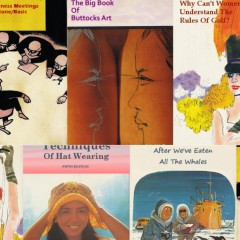Prelude To A Bloodbath (1974)
Facing criticism from an increasingly hostile press that its television programming was not preparing the then-present generation of children for what many assumed was going to be the decade-to-come, the 1980s, the British Broadcasting Corporation (sometimes known as the BBC) began to toughen up its output in 1974 starting with this annual based on the popular Basil Brush TV show. In addition to connect-the-dot puzzles, brainteasers, jokes about gay diseases, and facts about fox encroachment in urban environments a number of picture stories entertained the pre-teens who were the target audience for the book all of which culminated in the cheeky puppet Basil graphically tearing his companions to...
Japanese Book Translations
The publishing division of this website, neOnbubble Press, has had a long and varied history but one of its key positions has always been providing translation services of foreign publications to English speakers. For this post I thought I’d share just a handful of some of the quality book translations into English that neOnbubble Press has provided to the Japanese book and magazine markets since 1962. Winning Business Meetings The Sharon Stone/Basic Instinct Way Taking inspiration from films to run businesses has always been the Japanese way and books promoting that ethos have always been popular. The march towards miniaturisation of almost everything, for instance, can be traced back to the 1966 movie Fantastic Voyage. In 1993 neOnbubble Press translated Winning Business Meetings The Sharon Stone/Basic Instinct Way, a book suggesting a lack of underwear and crotchless suits could accelerate any Tokyo businessman right to the very top. Sales were poor. The Big Book Of Buttocks Art In the 1970s three schools of Japanese erotic arts competed with one another in the publishing marketplace: schoolgirl fetishism, tentacle rape, and drawings on buttocks. A quick search on the internet for those search terms will tell you all you need to know about whether the market could support all three types of art (spoiler: it couldn’t) and why subsequent sales of The Big Book Of Buttocks Art as translated and printed by neOnbubble Press were so poor. Why Can’t Women Understand The Rules Of Golf? Misogyny is prevalent in Japanese culture and that’s despite such groundbreaking books as Why Can’t Women Understand The Rules Of Golf?, published by neOnbubble Press in 1985, which sought to provide questions and answers to how women differed from men in stereotypically manly activities such as golf, karaoke, jerking off to schoolgirl fetishism and tentacle rape comic books, and alcoholism in a bid to promote discussions of equality. Sales were poor. Techniques Of Hat Wearing – Fifth Edition Throughout much of the eighties hat wearing enjoyed great popularity in Japan, and especially in Tokyo where there was a genuine (though unfounded) concern that neon leakage from signs could lead to hair loss. Many books on the subject had been printed and one of the most successful was Techniques Of Hat Wearing which had enjoyed three reprints with additions before neOnbubble Press was invited to translate and print a new one especially targeted at the emerging English-speaking market in the capital. Three weeks before the book hit the shops a scientific report allayed the public’s fears regarding neon leaks and the fad of hat wearing came to an abrupt end. Sales of the publication were poor. After...
Six Million Dollar Man Books
I recently saw some Six Million Dollar Man novel covers over on the always excellent Space 1970 blog and remembered that I too had a few hanging around somewhere. A quick rummage around the attic later led to me re-reading the books I’d not looked at in a couple of decades. A quick review of these TV show novelisations will now be forthcoming. #15: The Anteater Affair When a number of high profile assassinations around the globe are analysed it’s quickly realised that anteaters played a part in all of the deaths in some way. Steve Austin is tasked with the job of protecting the president of an emerging African nation on his visit to the United States as it is suspected that he will be the next target; this turns out not to be the case and the connection between anteaters and assassinations is purely coincidental. Overall, a disappointing adventure for the Six Million Dollar Man but I did learn a lot about anteaters and the administrative duties that take place in zoos. #23: Six Million And Two After Steve Austin suffers an allergic reaction to hayfever tablets he becomes obsessed with hippies and joins a commune. The allergic reaction is short-lived, however, and soon Steve’s right-wing tendencies come back in full force leading to a series of arguments with peaceful people about how they all should get real jobs. When the Six Million Dollar Man returns to his normal life he discovers that radioactive bees caused havoc in New York but everything’s okay now. The book concludes with Steve angry that he missed the bee adventure and further blaming of hippies. The free love orgy from pages 49 to 116 was a little contrived but the book had some good points to make about beatniks. #27: A Step Too Far When Steve Austin falls down the steps outside his new apartment he takes a sabbatical from work to pursue a private investigation into how widespread the stair-falling phenomenon is. A thrilling exposé into how to research old newspapers using your local library ensues. Probably the best of the Six Million Dollar Man novelisations and the most true to the TV episode on which it’s based. #28: 360 Degrees Of Death Steve Austin is invited to give safety talks in schools to students who are increasingly becoming interested with the new sport of skateboarding. Steve takes the opportunity to design a whole range of Six Million Dollar Man knee pads, elbow pads, and helmets but the kids reject his merchandise because of the butterfly designs on them and Steve’s fledgeling business runs into financial difficulties. Things become worse...
Product Placement On Vintage Book Covers
Long before the advertising behemoth sunk its behemothy teeth into the pure and unspoilt film industry it had successfully raped the once-innocent book realm. If you’re of a certain age and liked a certain kind of novel then you probably won’t have been able to have avoided some of the more gratuitous examples of the world of merchandising’s grotesque product placements. The Rasp It may look subtle but Fyffes paid for the addition of over forty bananas onto the dustjackets of hardcover books over the course of a two-year period and received a sales bump of nearly 19% as a result. The Edge Of Doom Switzerland’s neutrality in post-war America was a point of contention for those who’d grudgingly turned up to fight in it four years late themselves but a blitzkrieg advertising attack of cuckoo clocks, dull-looking heroes, and chocolate bars that hurt the roof of the mouth when eaten carelessly on the fronts of popular books helped raise the status of the little country to shrug level in double-quick time. The Passion Hunters It’s easy to think that Jenga just appeared from out of nowhere in the 1990s but the push for dominance in the world of games a bit like KerPlunk can be traced back to the vintage books on which its form first graced the covers. Swamp Hoyden If you thought the popular-with-rednecks sport of Nascar just magically hit upon the formula of "tiny little sponsorship logos all over things make money!" then think again: the lusting-after-hillbillies genre of vintage books was pushing the boundaries of just how many adverts were too many adverts decades earlier. Satan Was A Lesbian When market research tells you that sales of musical instruments are low among the important lesbian and Satan-worshipping demographics there’s only one thing you can do to turn that frown upside down. The Lust Pigs In a rare case the attempt to persuade the delinquents of society to take up curling through subliminal product placement on book covers failed spectacularly. Happily for the global curling cartel a switch in the seventies from alley-based play to ice and the removal of the ten-second rat rule paved the way for its inclusion in the Winter Olympics and its acceptance today as one of the things worth watching in the...
Top 10 Sci-Fi And Fantasy Books (*)
(*) That I’ve read and own. It’s an old internet law that lists of favourite things are a requirement of all websites annually. Well, this year I’m getting mine in early. I used to read a lot of fantasy but the genre holds less interest now that I’m older; science fiction has far more depth to it. Nevertheless, fantasy is represented here as there is a particularly cracking novel by C. J. Cherryh that I couldn’t omit. To prevent the rest of the list from weighing too heavily in one author or another’s favour I decided to limit my choices to only one book from any given author. Enough waffle… to the list! 10. The Forge Of God by Greg Bear The Earth’s about to be demolished to make way for a hyperspatial express route… no, wait, that’s something else entirely. But the Earth is about to be demolished and for the vast majority of the people on it that means a quite awe-inspiring description of death. 9. Against A Dark Background by Iain M. Banks How do you like your dark novels? Dark? Well, has Iain M. Banks got a treat for you! Not only is there the word ‘dark’ in the title, but the story is a masterpiece of dark and depressing science fiction at its finest. 8. Engines Of God by Jack McDevitt McDevitt’s books are, essentially, archaeological sci-fi. Yes, you’re right; that’s a pretty specific genre that might not appeal to those who like their science fiction devoid of exploration and digging. Me? I like it. Engines Of God is in this list, though, not because of its archaeology and interplanetary historical detective work but because it contains a sequence of chapters that I can only describe as unputdownablehighoctanepageturners. One word: tsunami. Ooh! Lovely bit of writing. 7. The Chronicles Of Morgaine by C.J. Cherryh The only fantasy representative on this list is actually three books in one! You’re being spoiled! And there’s more than a hint of sci-fi to satisfy the science fiction fan too. Gates to worlds separated by space and time, a sword called Changeling which has terrifying powers, and the best description of climate change gone awry you’ll ever find. 6. The Stars My Destination by Alfred Bester Essentially a tale of revenge… and teleportation! What more could you possibly want to know? 5. Brave New World by Aldous Huxley Another internet law you may already be aware of is that all science fiction lists must contain Brave New World or 1984 or both whether you like them or not. I do like them both but of the two Brave New...
Pretentious Book Reviews: Mr Greedy
The pleasant, friendly appearance of the title character belies the insatiable inner person that author Roger Hargreaves chooses as a metaphor for selfish destruction in the second book of his satirical world mythos inhabited by the eerily-named Mr Men. In 1887 John Emerich Edward Dalberg Acton, first Baron Acton (1834 – 1902) wrote in a letter to Bishop Mandell Creighton: Power tends to corrupt, and absolute power corrupts absolutely. Mr Greedy is the on-the-surface child-friendly representation of this but this is no child’s book; rather, it is a fable that crosses boundaries of age and background and it warns of the ultimately doomed dangers not just of power but any addiction. Hargreaves simplifies the 19th century message and substitutes power with the physical substance we all know: food. This is a master’s stroke of genius on the author’s part. The seeking of power is not, after all, universal; there are those who are content to simply be. But the need for food is a craving we cannot simply turn off or something to which people either take or leave. It is always there. For an addict – power, drugs, cigarettes, alcohol, gambling, religion, and so on – there is a similar need but the vast majority of people are not addicts. Baron Acton’s stark warning strikes a chord; Roger Hargreaves’ Mr Greedy character sets free a macabre symphony from the orchestra. Selfish destruction is self-serving says Hargreaves. Mr Greedy likes to eat. Eating makes him fat. Becoming fat makes him hungrier. Ad infinitum. He lives in a house, says the author, "that looked rather like himself." It is the nature of the addict to barricade his or herself with reinforcing surroundings. The roly-poly house of Mr Greedy is instantly recognisable as the Yes Men that protect the tyrannical business executive from reality. There is a similar fantasy that encases everyone who falls for destructive addiction. The physical appearance of Mr Greedy lets us know that what we are reading about is wrong, as if we needed telling. Yes, this is a personable character, a smiling character, perhaps someone we might enjoy being around. But Hargreaves doesn’t want us sympathising too much; at the heart of the story is a great exclamation mark: stop! Enough! Mr Greedy is fat and we all simply know without needing to be told that fat is bad. Each page turn heightens the anticipation of Mr Greedy’s undoing. Hargreaves’ writing style is superb in keeping us alert for the come-uppance and yet simultaneously lulling us, rocking us gently along. As humans we recognise this; it’s when we know we’re doing something wrong and we think...



















Recent Comments